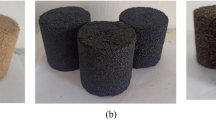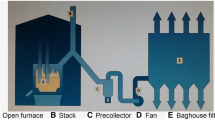Abstract
Although sand systems containing Na-silicate binder present several environmental and economic advantages, technological applications are restricted due to their poor knock-out properties and low moisture resistance. Thus, many investigations have been performed recently to eliminate these undesirable handicaps of Na-silicate binder. In this study, the technological importance of a recently developed Na-silicate binder with a liquid hardener and its applicability in a mold/core system have been investigated. Further, a casting trial of a tank rear idler wheel has been performed by using the molds prepared with the current Na-silicate binder, and the observations have been evaluated. It has been determined that using Na-silicate binder results in more important advantages and benefits such as shorter period (10 s) for CO2 application, sound mold surface without cavity, good gas permeability, long shelf-life at high moisture environment (90% moisture at 23 °C for 24 h), and achieving silica sand-based mold/core systems with superior shakeout property than that of the conventional ones. It has been observed that the preparation of molds with the current Na-silicate binder hardened by CO2 process and the liquid Na-silicate hardener provides a practically odorless and fast process, and outstanding casting quality during the trials.






Similar content being viewed by others
References
D. Warren, Br. Foundrym. 64(12), 52–56 (1971)
F. Czerwinski, M. Mir, W. Kasprzak, Int. J. Cast Metal Res. 28(3), 129–139 (2015)
D. Drożyński, A. Bobrowski, M. Holtzer, Arch. Foundry Eng. 15(1), 138–142 (2015)
G. Gigante, Int. J. Met. (2010). https://doi.org/10.1007/BF03355494
M.B. Parappagoudar, D.K. Pratihar, G.L. Datta, Mater. Manuf. Process. 23, 59–67 (2009)
S. Robert E, W. Robert J, U.S. Patent No. 2, 765, 507, 9 Oct 1956
H. E. Bergna, U.S. Patent No. 4, 316, 744, 23 Feb 1982
M.A. Boyle, C.J. Martin, J.D. Neuner, in Neuner, in Epoxy Resins, ed. by B. Miracle, S.L. Donaldson (ASM International, Materials Park, 2001), p. 78
J.A. Heth, in Safety and Health Issues, ed. by S.T. Peters (Chapman & Hall, London, 1998), p. 832
R.K. Ohdar, P.T. Pushp, J. Eng. Manuf. (2003). https://doi.org/10.1243/095440503321628152
F. Zitian, H. Naiyu, D. Xuanpu, Int. J. Cast Met. Res. 17(1), 51–56 (2004)
R.M. Andrade, S. Cava, S.N. Silva, L.E.B. Soledade, C.C. Rossi, E.R. Leite, C.A. Paskocimas, J.A. Varela, E. Longo, J. Mater. Process. Technol. 159(1), 125–134 (2005)
V. LaFay, Int. J. Met. (2012). https://doi.org/10.1007/BF03355530
H.G.F. Kunsmann, AFS Trans. 79, 488–492 (1971)
S. A. Barker, N. Baggett, J. Stevenson, D. R. deCourcy, U.S. Patent No. 4,504,314, 12 Mar 1985
W. Schumacher, AFS Trans. 63, 488–492 (1955)
H. Chang, E.L. Chen, R. Lindeke, AFS Trans. 96, 217–222 (1988)
W. Jina, F. Zitian, Z. Xiaolei, P. Di, China Foundry 6(3), 191–196 (2009)
L. Zaretskiy, Int. J. Met. (2016). https://doi.org/10.1007/s40962-015-0005-3
L. Zaretskiy, Int. J. Met. (2017). https://doi.org/10.1007/s40962-017-0155-6
Ala-Merset, Characterization Study of Casting Binders Information Sheet 26052015 (Alazan Casting Chemicals & Industry Metal Inc. Co., Kocaeli, Turkey, 2015)
W.H. Moore, W.E. Gruver, Jr., U.S. Patent No. 2,883,723, 28 Apr 1959
R.H. Cooper, U.S. Patent No. 3,230,099, 18 Jan 1966
J.R. Brown (ed.), Foseco Ferrous Foundryman’s Handbook (Replika Press Pvt Ltd, Delhi, 2000), pp. 204–215
M. Holtzer, D. Drożyński, A. Bobrowski, W. Plaza, Arch. Foundry Eng. 14(1), 37–40 (2014)
T.V.R. Rao, Metal Casting: Principles and Practice, 5th edn. (New Age International, New Delhi, India, 2010)
https://en.wikipedia.org/wiki/Permeability (foundry_sand). Accessed 25 May 2017
R.E. Melcher, F.W. Schaefer, U.S. Patent No. 4,131,476, 26 Dec 1978
GF Sand Testing Equipment Catalog, George Fischer Limited, Schaffhausen, Switzerland
N. D. Miller, Patent WO1995015229 A1, 8 Jun 1995
Acknowledgements
Alazan Casting Chemicals & Industry Metal Inc. Co. is gratefully acknowledged for permission to publish this work. Corresponding author would like to thank the Editor and Reviewers of the International Journal of Metalcasting due to their highly valuable critical comments. Authors are also grateful to Anadolu Steel Casting Inc.Co., Kocaeli, Turkey, for their help during the casting trials of this study.
Author information
Authors and Affiliations
Corresponding author
Rights and permissions
About this article
Cite this article
Ünlü, N., Odabaş, A. Development and Evaluation of a New Eco-friendly Sodium Silicate-Based Binder System. Inter Metalcast 12, 765–771 (2018). https://doi.org/10.1007/s40962-018-0210-y
Published:
Issue Date:
DOI: https://doi.org/10.1007/s40962-018-0210-y




